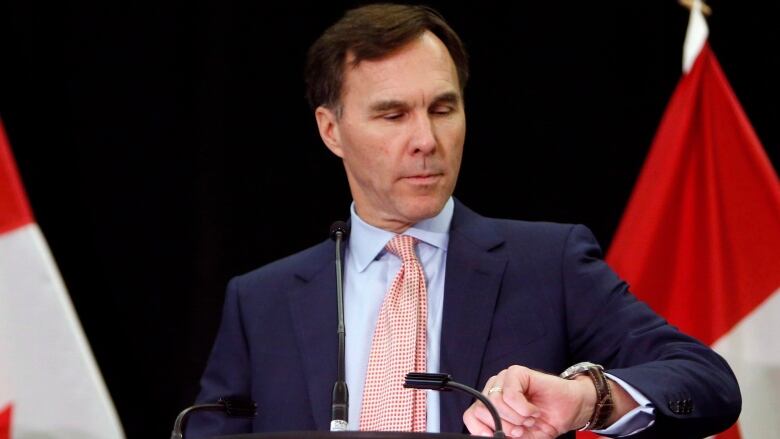How tax and other changes coming Jan. 1 will affect your wallet
New employment insurance rules, cancelled tax credits among changes for 2017

There were plenty of changes in 2016as the Trudeau government put its priorities in motion.
When Canadians file their taxes this spring, they'llcalculatehow new tax rates and child benefits worked out for their household.
But the changes don't stop there. The start of 2017 brings a bunch more.
Here's some of whatto expect.
More carbon pricing
Some Canadians already feelthe effects of the fight againstclimate change in their wallets.
B.C. residents have paid a carbon taxsince 2008. Quebec residentshave absorbedthe cost of that province'scap-and-trade system since 2013.
As of Jan. 1, the prevalence of these kinds of costs expands, particularly in two provinces, as federal and provincialemissions reduction plansramp up.
- Happy New Year, Albertans: Here's your carbon tax bill
- Judge climate plan on emissions trend in 2019, Trudeau says
In Alberta, there's a new carbon tax.
Emissions from burning fossil fuels will be taxed at a rate of $20 per tonne.That increases to $30 per tonnein 2018, and Premier Rachel Notley's government is expected to keep movingtowards the federal goal of $50 per tonne by 2022.
How much will that cost an Alberta household? Try CBC'scarbon tax calculator.

Ontario's alternative plan acap-and-trade scheme that auctions off pollution credits to offer a financialincentive to reduce emissions also kicks in.
Its overallimpactremainsto be seen. But Premier Kathleen Wynne's government has warned consumers the system may add about $5 a month to home heating bills and about four cents per litre to the price of gasoline.
Payroll deduction changes
Here's what to look for on your firstpay stub in2017.
Employment insurance (EI)and Canada Pension Plan (CPP) deductions willreappear on the paycheques of workers who maxed out their deductions part way through 2016.
But themove to a new, seven-year "break-even" calculation for EIpremiums could bring savings worth up to $118.85 annually for those making $51,300 or more.
Previous premiums, set at $1.88 per $100 earned, were delivering more revenue to the government than it required to administer and pay benefits. A new,lower premium was announced in September for workers ($1.63) and employers ($1.63 x 1.4 = $2.28). Some smallemployers qualify for an additionalpremium reduction.

In Quebec, where EI worksdifferently, 2017 premiums will be $1.27 per $100 of earnings, down from $1.52. Quebec residents covered under the Quebec Parental Insurance Plan (QPIP) will see their premiums reducedby 36 cents.
The lower payroll deductions maytranslate into$955 million in savingsfor employees and their employers. (That'salso less revenue for the federal government to balance its books.)
The maximum annual insurable earnings for both EI and CPPare indexed to inflation and will increase slightly in2017.
Thattranslates into deductions of up to $836.19 forEIand $2,564.10 for CPP.
ThatCPP premium has risen by$19.80 for those making $55,300 or more partly offsettingthe savings from the EI premium cut.
The agreementbetween the federal government and the provinces (excluding Quebec) to enhancethe CPP won't be felt until 2019, when contributions begin rising over seven years at levels beyond this year's adjustment for inflation.
Workers may also notice the effects of indexation on the amount of federal tax deducted from their pay. Federal income tax thresholds, the basic personal amount andseveral other credit amounts, will increaseby 1.4 per cent for 2017.

Shorter waiting periodfor EI
The two-week waiting period before EI benefits, including special benefits for maternity or disability leave,start paying out will be reduced to one week starting Jan. 1.
Employers that co-ordinate their benefits with EI may need to adjust for the shorter wait time.
Self-employed workers who opted in to the EI system and wish to draw on special benefits in 2017 will need to have earned a little more in order to qualify: the annual earnings requirement increasesto $6,888, upfrom$6,820 in2016.
Tax credit elimination
Several federal tax credits have been eliminated for 2017. (That doesn't mean you can't claim them one last time this spring on your 2016 tax return.)
Federal textbook and education tax credits have been eliminatedbecause they'renot targeted based on income income-targeted policy has been apriority for thisLiberal government. Leftover amounts from thesetax credits carried forward before 2017 canstill be claimedin subsequent years.
The tuition tax credit remains unchanged.

Thechildren's fitness and artscredits areeliminatedfor2017, after being cut in half for 2016.
The federal credit for labour-sponsored venture capital corporationshas also been eliminated, although afederal tax credit for provincially registered corporations was restored in 2016 and is worthup to $750.
Life insurance taxchanges
A bill passed under the previous Conservative government in 2014to "modernize"the taxation of life insurance policies also takeseffect Jan.1. The delay gaveCanadians planning their retirements and the insurance industry time to prepare for the change.
In simplest terms, the changes impact the total amount of money that can accumulate in a life insurance policy that gets preferential tax treatment. The changes aim to differentiatebetween protection-oriented policies and investment-oriented policies.
Policies issued prior to Jan.1 are "grandfathered,"so the changes won'tretroactively affect retirementplans unlesschanges are madeafter this date, such as converting to another type of policy coverage.
The amount of tax paid on a prescribed annuity ischanging, asthe CanadaRevenue Agency updatesitstables to reflect longer expected lifespans. Annuities bought before the end of 2016 could provide higher after-tax income than those purchased later.
And don't forget: after rising to $10,000 in 2015, thelimit for contributions to a tax-free savings account dropped back to $5,500 and stays there for 2017.
Free admission to national parks
If calculating the impact of this is giving you a math headache, head to one of Canada's national parks for a break.
Admission is free throughout 2017to markCanada's 150th anniversary.














_(720p).jpg)


 OFFICIAL HD MUSIC VIDEO.jpg)
.jpg)



























































































